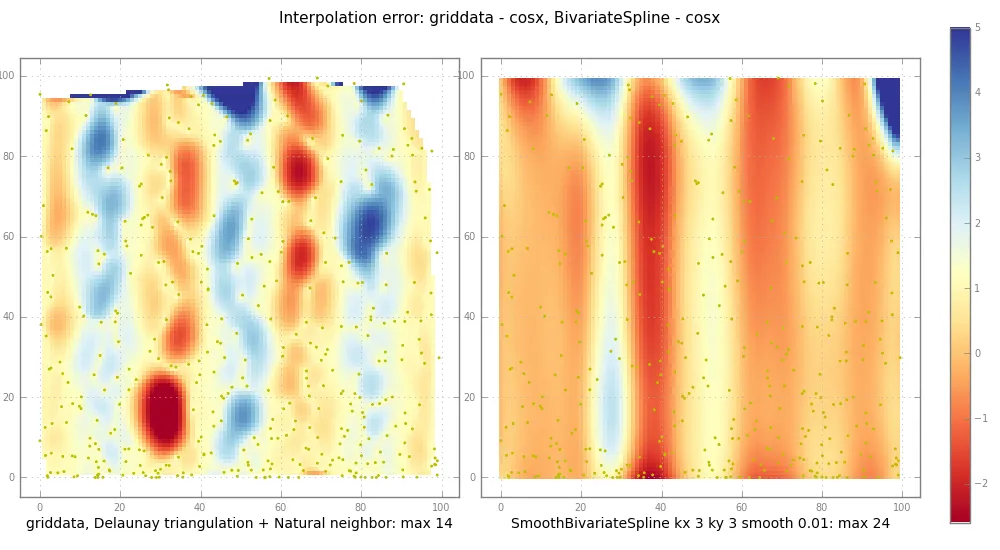8月27日更新:Kyle在scipy-user thread中继续跟进。
8月30日更新:@Kyle,看起来笛卡尔坐标系X,Y和极坐标系Xnew,Ynew有混淆。请参见下面过长的注释中的“polar”。

from __future__ import division
import sys
import numpy as np
from scipy.interpolate import SmoothBivariateSpline
from matplotlib.mlab import griddata
__date__ = "2010-10-08 Oct"
def avminmax( X ):
absx = np.abs( X[ - np.isnan(X) ])
av = np.mean(absx)
m, M = np.nanmin(X), np.nanmax(X)
histo = np.histogram( X, bins=5, range=(m,M) ) [0]
return "av %.2g min %.2g max %.2g histo %s" % (av, m, M, histo)
def cosr( x, y ):
return 10 * np.cos( np.hypot(x,y) / np.sqrt(2) * 2*np.pi * cycle )
def cosx( x, y ):
return 10 * np.cos( x * 2*np.pi * cycle )
def dipole( x, y ):
r = .1 + np.hypot( x, y )
t = np.arctan2( y, x )
return np.cos(t) / r**3
testfunc = cosx
Nx = Ny = 20
Newx = Newy = 100
cycle = 3
noise = 0
ypow = 2
imclip = (-5., 5.)
kx = ky = 3
smooth = .01
seed = 1
plot = 0
exec "\n".join( sys.argv[1:] )
np.random.seed(seed)
np.set_printoptions( 1, threshold=100, suppress=True )
print 80 * "-"
print "%s Nx %d Ny %d -> Newx %d Newy %d cycle %.2g noise %.2g kx %d ky %d smooth %s" % (
testfunc.__name__, Nx, Ny, Newx, Newy, cycle, noise, kx, ky, smooth)
X, Y = np.random.uniform( size=(Nx*Ny, 2) ) .T
Y **= ypow
Z = testfunc( X, Y )
if noise:
Z += np.random.normal( 0, noise, Z.shape )
z2sum = np.sum( Z**2 )
xnew = np.linspace( 0, 1, Newx )
ynew = np.linspace( 0, 1, Newy )
Zexact = testfunc( *np.meshgrid( xnew, ynew ))
if imclip is None:
imclip = np.min(Zexact), np.max(Zexact)
xflat, yflat, zflat = X.flatten(), Y.flatten(), Z.flatten()
print "SmoothBivariateSpline:"
fit = SmoothBivariateSpline( xflat, yflat, zflat, kx=kx, ky=ky, s = smooth * z2sum )
Zspline = fit( xnew, ynew ) .T
splineerr = Zspline - Zexact
print "Zspline - Z:", avminmax(splineerr)
print "Zspline: ", avminmax(Zspline)
print "Z: ", avminmax(Zexact)
res = fit.get_residual()
print "residual %.0f res/z2sum %.2g" % (res, res / z2sum)
print ""
print "griddata:"
Ztri = griddata( xflat, yflat, zflat, xnew, ynew )
nmask = np.ma.count_masked(Ztri)
if nmask > 0:
print "info: griddata: %d of %d points are masked, not interpolated" % (
nmask, Ztri.size)
Ztri = Ztri.data
trierr = Ztri - Zexact
print "Ztri - Z:", avminmax(trierr)
print "Ztri: ", avminmax(Ztri)
print "Z: ", avminmax(Zexact)
print ""
if plot:
import pylab as pl
nplot = 2
fig = pl.figure( figsize=(10, 10/nplot + .5) )
pl.suptitle( "Interpolation error: griddata - %s, BivariateSpline - %s" % (
testfunc.__name__, testfunc.__name__ ), fontsize=11 )
def subplot( z, jplot, label ):
ax = pl.subplot( 1, nplot, jplot )
im = pl.imshow(
np.clip( z, *imclip ),
cmap=pl.cm.RdYlBu,
interpolation="nearest" )
ny, nx = z.shape
pl.scatter( X*nx, Y*ny, edgecolor="y", s=1 )
pl.xlabel(label)
return [ax, im]
subplot( trierr, 1,
"griddata, Delaunay triangulation + Natural neighbor: max %.2g" %
np.nanmax(np.abs(trierr)) )
ax, im = subplot( splineerr, 2,
"SmoothBivariateSpline kx %d ky %d smooth %.3g: max %.2g" % (
kx, ky, smooth, np.nanmax(np.abs(splineerr)) ))
pl.subplots_adjust( .02, .01, .92, .98, .05, .05 )
cax = pl.axes([.95, .05, .02, .9])
pl.colorbar( im, cax=cax )
if plot >= 2:
pl.savefig( "tmp.png" )
pl.show()
关于2D插值,BivariateSpline和griddata的区别。
scipy.interpolate.*BivariateSpline和matplotlib.mlab.griddata
都需要1D数组作为参数:
Znew = griddata( X,Y,Z, Xnew,Ynew )
# 1d X Y Z Xnew Ynew -> interpolated 2d Znew on meshgrid(Xnew,Ynew)
assert X.ndim == Y.ndim == Z.ndim == 1 and len(X) == len(Y) == len(Z)
输入的
X,Y,Z描述了三维空间中的一个平面或点云:
X,Y(或纬度、经度等)是平面上的点,而
Z则是它上面的一个表面或地形。
X,Y可能填满大部分矩形[Xmin..Xmax] x [Ymin..Ymax],也可能只是其中的一个波浪形S或Y。
Z表面可以是光滑的,也可以是光滑加上一些噪声,或者根本不光滑,像粗糙的火山山脉。
Xnew和
Ynew通常也是一维的,描述了一个矩形网格,其中有|Xnew| x |Ynew|个点,你想要在这个网格上进行插值或估计Z。
Znew = griddata(...)返回这个网格上的二维数组,np.meshgrid(Xnew,Ynew):
Znew[Xnew0,Ynew0], Znew[Xnew1,Ynew0], Znew[Xnew2,Ynew0] ...
Znew[Xnew0,Ynew1] ...
Znew[Xnew0,Ynew2] ...
...
当输入的X,Y坐标值与新的Xnew,Ynew坐标值相差较大时,griddata方法会出现问题。
如果任何网格点在输入数据定义的凸包外部(不进行外推),则返回掩码数组。
(“凸包”是由所有X,Y点围成的虚拟橡皮筋所包含的区域。)
griddata方法的工作原理是首先构建输入X,Y的Delaunay三角剖分,然后进行自然邻居插值。这种方法具有鲁棒性和很快的速度。
然而,BivariateSpline方法可以外推,而且会没有警告地生成极端值。此外,Fitpack中的所有*Spline方法都对平滑参数S非常敏感。Dierckx的书(books.google isbn 019853440X p. 89)上写道:
如果S太小,则样条近似过于起伏,并且会捕捉到太多噪声(过拟合);
如果S太大,则样条将过于平滑并且会丢失信号(欠拟合)。
离散数据的插值很困难,平滑也不容易,而两者同时进行则更加困难。如果XY数据存在大的空洞或非常嘈杂的Z值,那么插值方法应该如何处理呢?(“如果你想卖掉它,你必须对其进行描述。”)
还有更多注意事项:
1维 vs 2维:某些插值方法接受1维或2维的X,Y,Z值。其他插值方法仅接受1维值,因此在插值之前请将其展平:
Xmesh, Ymesh = np.meshgrid( np.linspace(0,1,Nx), np.linspace(0,1,Ny) )
Z = f( Xmesh, Ymesh )
Znew = griddata( Xmesh.flatten(), Ymesh.flatten(), Z.flatten(), Xnew, Ynew )
关于遮罩数组:Matplotlib 可以很好地处理它们,仅绘制未被遮罩/非 NaN 的点。但是我不敢保证一些愚蠢的 NumPy/SciPy 函数能正常工作。检查 X、Y 外凸壳之外的插值,可以像这样:
Znew = griddata(...)
nmask = np.ma.count_masked(Znew)
if nmask > 0:
print "info: griddata: %d of %d points are masked, not interpolated" % (
nmask, Znew.size)
在极坐标系下:
X、Y 和 Xnew、Ynew 应该在同一个空间中,都是直角坐标系,或者都在 [rmin .. rmax] x [tmin .. tmax] 范围内。
要在三维空间中绘制 (r, theta, z) 点:
from mpl_toolkits.mplot3d import Axes3D
Znew = griddata( R,T,Z, Rnew,Tnew )
ax = Axes3D(fig)
ax.plot_surface( Rnew * np.cos(Tnew), Rnew * np.sin(Tnew), Znew )
参见(未尝试):
ax = subplot(1,1,1, projection="polar", aspect=1.)
ax.pcolormesh(theta, r, Z)
对于谨慎的程序员,有两个提示:
检查异常值或奇怪的缩放:
def minavmax( X ):
m = np.nanmin(X)
M = np.nanmax(X)
av = np.mean( X[ - np.isnan(X) ])
histo = np.histogram( X, bins=5, range=(m,M) ) [0]
return "min %.2g av %.2g max %.2g histo %s" % (m, av, M, histo)
for nm, x in zip( "X Y Z Xnew Ynew Znew".split(),
(X,Y,Z, Xnew,Ynew,Znew) ):
print nm, minavmax(x)
检查简单数据的插值:
interpolate( X,Y,Z, X,Y ) -- interpolate at the same points
interpolate( X,Y, np.ones(len(X)), Xnew,Ynew ) -- constant 1 ?
